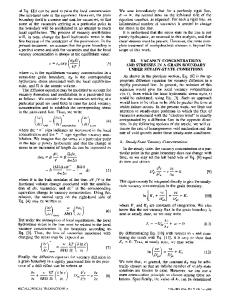Void nucleation in metal interconnects: Combined effects of interface flaws and crystallographic slip
- PDF / 538,320 Bytes
- 8 Pages / 612 x 792 pts (letter) Page_size
- 38 Downloads / 298 Views
MATERIALS RESEARCH
Welcome
Comments
Help
Void nucleation in metal interconnects: Combined effects of interface flaws and crystallographic slip Y-L. Shen Department of Mechanical Engineering, The University of New Mexico, Albuquerque, New Mexico 87131 (Received 5 September 1997; accepted 29 April 1998)
A micromechanical model of void nucleation in passivated metal interconnection lines is proposed. The model is based on the evolution of stress and strain fields in a two-dimensional model system, obtained from numerical modeling. Interface flaws in the form of debond between the metal and the surrounding dielectric are assumed to exist. A unique pattern of shear stress resolved on the slip systems in the metal line, due to the presence of pre-existing debond, is found. A dislocation slip model is constructed in accordance with the shear mode. The mechanism of crystallographic slip is such that lateral thinning of the metal line at the debond region together with the slip step produced at the edges of debond lead to a net transport of atoms away from the debond area, and a physical void is thus formed. The significance and implications of this proposed micromechanism are discussed.
I. INTRODUCTION
Patterned and encapsulated thin metallic films are used as interconnection lines for conducting electric signals, to form a functional circuit in modern microelectronic devices. Because of the thermal expansion mismatch between the metal and the surrounding dielectric and substrate materials, high tensile stresses are generated in metal lines upon cooling from the fabrication temperature. The formation of voids in aluminum interconnects resulting from the thermal stress has been a major reliability concern in microelectronics. Numerous theoretical and experimental studies have appeared in the literature, as reviewed in Refs. 1 and 2, including several variations of void growth modeling predicated upon the diffusional processes of atoms. Void nucleation, however, may still be the least understood aspect of stress-induced voiding. From a practical standpoint, developing a fundamental understanding of void nucleation is very important, because preventing the damage initiation may be a more reliable way than attempting to extend the designed lifetime by controlling void growth. Recently there have been strong indications that voids in metal interconnects tend to form at the side-wall interface between the metal and the dielectric, and the pre-existing interface flaws resulting from contamination such as etch residue serve as sites for void nucleation. This stems from the theoretical analysis within the context of classical nucleation theory,3,4 detailed microstructural observations of stress-induced and electromigration void initiation,5 and experiments revealing that additional cleaning processes can dramatically suppress voiding in aluminum interconnects.6,7 In the present work a two-dimensional micromechanism of void initia584
http://journals.cambridge.org
J. Mater. Res., Vol. 14, No. 2, Feb 1999
Downloaded: 14 Mar
Data Loading...











